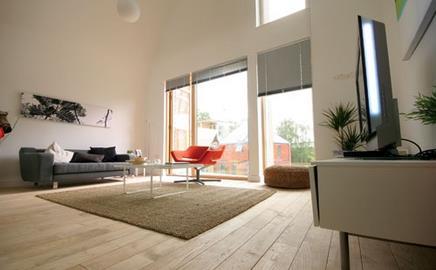It doesnŌĆÖt matter how energy-efficient a home is ŌĆō if the interior doesnŌĆÖt look great, nobody will buy it. Chloe Stothart checks out the latest products hoping to persuade the public that green is good
Over the past couple of years the environment-friendly house, which used to be a fairly marginal concern of the housebuilding industry, has moved to centre stage.
This presents housebuilders with two problems. The first is how to design and build a mainstream product for the right price. The second is how to convince buyers that the greywater recycling systems and biomass boilers that help make it all possible will not affect their everyday lives.
One of their trump cards is that this technology is often out of sight and out of mind. But what customer-friendly solutions are there for the area of the home that is always on show: the interior?
DesignersŌĆÖ creativity is particularly tested by the more ambitious sustainable homes, such as BedZED, the south London granddaddy of sustainable housing development. This has now been joined by a country cousin, RuralZED, designed by the ZEDfactory arm of Bill Dunster Architects. On the inside, some models use polished concrete floor tiles as well as concrete wall panels and terracotta tiles in the ceiling. This may sound institutional, but these materials are hardwearing and have good thermal mass, meaning they absorb coolth during the night and heat during the day, which makes for better temperature regulation.
The key to the success of these materials is that the surface is left exposed, which presents a challenge to designers and manufacturers. ŌĆ£We have to make it look good so people donŌĆÖt want to cover it up,ŌĆØ says Matthew Hoad, director of ZEDFactory. ŌĆ£A lot of the things people like in traditional build are the quality of stone and light, and that is what we are looking at.ŌĆØ
To create a visually attractive space, the concrete panels of ZED homes can be sealed to improve their appearance and allow them to be painted. ZEDFactory sometimes opts for white paint on the walls to increase the reflectivity of light and heat in order to save energy. Like many builders of eco-homes, they opt for kitchen units made from recycled materials. Marmoleum, a natural lino made of chalk and lime, is used in the wet areas of the house. Chalk-based paints, low in volatile chemicals, that allow the walls to ŌĆ£breatheŌĆØ by passing moisture through, are used and any carpets are woollen without a backing, and so do not contain any damaging chemicals.
Of course, the environment-friendly materials should not have to be frequently binned and replaced. Many of these traditional materials are durable, but the design also has to withstand the ages. Hoad says: ŌĆ£We expect the build to last five generations or more. We look for robust detailing so people are not continually wanting to refit it.ŌĆØ
Another well-known take on the eco-home is Sheppard RobsonŌĆÖs Lighthouse, a version of which stands in the grounds of BREŌĆÖs headquarters in Watford (left). The building is the UKŌĆÖs first zero-carbon home to meet the top level of the Code for Sustainable Homes. It too uses the thermal mass of its materials to regulate temperature, but in this case the designers went for phase-change materials that look like normal plasterboard.
Martin Rose, project leader for the Lighthouse at Sheppard Robson, says the plain appearance of the materials ŌĆō which look like skimmed plasterboard ŌĆō was the key to getting the public to accept an eco-home.
ŌĆ£We felt it was important to have things that did not look too unusual and the philosophy of the house is to be completely lightweight,ŌĆØ he says. ŌĆ£The materials we got from Kingspan were light and we wanted a consistent approach. Historically there have been a lot of heavyweight solutions to thermal mass, like concrete, so it was a challenge to engineer this with a light weight.ŌĆØ
The phase-change panels were used in the ceiling, where they were less likely to have picture hooks or fittings screwed into them, which would upset their thermal properties. On the floor was wool carpet or natural rubber consisting of 2mm of recycled material and a 2mm coloured layer. The house was built for an exhibition so the durable rubber floors were also a good choice to withstand visitors tramping in and out, as well as coming in attractive colours.
But flagship projects aside, the range of interiors products has increased rapidly in recent months. ŌĆ£I think the move to environment-friendly houses has had an impact on finishing for interiors,ŌĆØ says Michael Sandford, senior interior designer at architect PRP. ŌĆ£ItŌĆÖs not like the old days where if it was environment-friendly it was brown and awful-looking. Now the technologies and peopleŌĆÖs ideas have moved on. It is a fashion but I think it will grow and grow.ŌĆØ
In the products on offer, there has been a return to traditional, natural materials such as wool, felt, solid wood and cork. All have practical benefits ŌĆō wool and felt can dampen acoustics, for example ŌĆō but they are all aesthetically pleasing as well.
There have also been some more exotic examples of green interiors. Sandford has specified paper furniture and screens in an Austrian restaurant. The paper had a corrugated effect and was robust, he recalls.
With the housing market in freefall and consumers tightening their belts, what is the future for these interior products? Two large suppliers, the Greenshop and the Green ║┌Č┤╔ńŪ° Store, have not noticed a significant downturn in sales yet. Jane Powell, manager of the Greenshop, says eco-friendly paint sales have gone up because homeowners are choosing to stay put and revamp their properties rather than move. Those working in creating eco-friendly interiors hope the publicŌĆÖs awakening to environmental issues will see the industry through these tough times.




























No comments yet